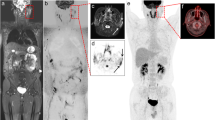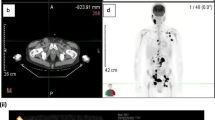Abstract
Introduction
This study prospectively evaluated whole-body magnetic resonance/diffusion-weighted imaging with body signal suppression (WB-MR/DWIBS) reliability compared to 18F-FDG PET/CT in the treatment response assessment of classic Hodgkin lymphomas (HL) and aggressive non-Hodgkin lymphomas (aNHL).
Materials and methods
Twenty-seven consecutive patients were prospectively enrolled at the time of diagnosis. Eighteen (11 HL and seven aNHL) were considered for the analysis. They received chemo/radiotherapy as induction and completed post-treatment evaluation performing both 18F-FDG PET/CT and WB-MR/DWIBS. The revised response criteria for malignant lymphomas were used to assess the response to treatment. We evaluated the agreement between the two methods by Cohen’s K test. Post-therapy WB-MR/DWIBS sensitivity, specificity, PPV, NPV and accuracy were then calculated, considering the 12 months of follow-up period as the gold standard.
Results
By using an evaluation on a lesion-by-lesion basis, WB-MR/DWIBS and 18F-FDG PET/CT showed an overall good agreement (K = 0.796, 95 % IC = 0.651–0.941), especially in the evaluation of the nodal basins in aNHL (K = 0.937, 95 % IC = 0.814–1). In reference to the revised response criteria for malignant lymphomas, the two methods showed a good agreement (K = 0.824, 95 % IC = 0.493–1). Post-therapy sensitivity, specificity, PPV, NPV and accuracy of WB-MR/DWIBS were 43, 91, 75, 71 and 72 %, respectively.
Conclusion
WB-MR/DWIBS seems to be an appropriate method for the post-treatment assessment of patients affected by HL and aNHL. The small discrepancies between the two methods found within HL could be due to the biological and metabolic behavior of this group of diseases. Larger prospective studies are necessary to better define the role of WB-MR/DWIBS in this setting of patients.





Similar content being viewed by others
References
Wu X, Kellokumpu-Lehtinen PL, Pertovaara H, Korkola P, Soimakallio S, Eskola H et al (2011) Diffusion-weighted MRI in early chemotherapy response evaluation of patients with diffuse large B-cell lymphoma–a pilot study: comparison with 2-deoxy-2-fluoro- d-glucose-positron emission tomography/computed tomography. NMR Biomed 24(10):1181–1190
Antoch G, Vogt FM, Freudenberg LS, Nazaradeh F, Goehde SC, Barkhausen J et al (2003) Wholebody dual-modality PET/CT and whole-body MRI for tumor staging in oncology. J Am Med Assoc 290:3199–3206
Cheson BD, Horning SJ, Coiffier B, Shipp MA, Fisher RI, Connors JM et al (1999) Report of an international workshop to standardize response criteria for non-Hodgkin’s lymphomas. NCI Sponsored International Working Group. J Clin Oncol 17(4):1244
Cheson BD, Pfistner B, Juweid ME et al (2007) Revised response criteria for malignant lymphoma. J Clin Oncol 25(5):579–586
Wu X, Pertovaara H, Korkola P, Dastidar P, Järvenpää R, Eskola H et al (2014) Correlations between functional imaging markers derived from PET/CT and diffusion-weighted MRI in diffuse large B-Cell lymphoma and follicular lymphoma. PLoS One 9(1):e84999
Zink D, Fischer AH, Nickerson JA (2004) Nuclear structure in cancer cells. Nat Rev Cancer 4:677–687
Takahara T, Imai Y, Yamashita T et al (2004) Diffusion weighted whole body imaging with background body signal suppression (DWIBS): technical improvement using free breathing, STIR and high resolution 3D display. Radiat Med 22(4):275–282
Brennan DD, Gleeson T, Coate LE et al (2005) A comparison of whole-body MRI and CT for the staging of lymphoma. AJR Am J Roentgenol 185(3):711–716
Kwee TC, Kwee RM, Nievelstein RA (2008) Imaging in staging of malignant lymphoma: a systematic review. Blood 111(2):504–516
Punwani S, Taylor SA, Saad ZZ, Bainbridge A, Groves A, Daw S et al (2013) Diffusion-weighted MRI of lymphoma: prognostic utility and implications for PET/MRI? Eur J Nucl Med Mol Imaging 40(3):373–385
Marzolini M, Wong WL, Ardeshna K, Padhani A, D’Sa S (2012) Diffusion-weighted MRI compared to FDG PET-CT in the staging and response assessment of Hodgkin lymphoma. Br J Haematol 156(5):557
Chen Y, Zhong J, Wu H, Chen N (2012) The clinical application of whole-body diffusion-weighted imaging in the early assessment of chemotherapeutic effects in lymphoma: the initial experience. Magn Reson Imaging 30(2):165–170
Lin C, Luciani A, Itti E et al (2010) Whole-body diffusion-weighted magnetic resonance imaging with apparent diffusion coefficient mapping for staging patients with diffuse large B-cell lymphoma. Eur Radiol 20(8):2027–2038
Ferrari C, Minoia C, Asabella AN, Nicoletti A, Altini C, Antonica F, Ficco M et al (2014) Whole body magnetic resonance with diffusion weighted sequence with body signal suppression compared to (18)F-FDG PET/CT in newly diagnosed lymphoma. Hell J Nucl Med 17Suppl(1):40–49
Juweid ME, Stroobants S, Hoekstra OS, Mottaghy FM, Dietlein M, Guermazi A et al (2007) Imaging Subcommittee of International Harmonization Project in Lymphoma. Use of positron emission tomography for response assessment of lymphoma: consensus of the Imaging Subcommittee of International Harmonization Project in Lymphoma. J Clin Oncol 25(5):571–578
De Paepe K, Bevernage C, De Keyzer F, Wolter P, Gheysens O, Janssens A et al (2013) Whole-body diffusion-weighted magnetic resonance imaging at 3 Tesla for early assessment of treatment response in non-Hodgkin lymphoma: a pilot study. Cancer Imaging 13:53–62
Kostakoglu L, Cheson BD (2013) State-of-the-art research on lymphomas: role of molecular imaging for staging, prognostic evaluation, and treatment response. Front Oncol 3:212
Komori T, Narabayashi I, Matsumura K et al (2007) 2-[Fluorine-18]-fluoro-2-deoxy-d-glucose positron emission tomography computed tomography versus whole-body diffusion-weighted MRI for detection of malignant lesions: initial experience. J Ann Nucl Med 21:209–215
Nakanishi K, Kobayashi M, Nakaguchi K et al (2007) Whole-body MRI for detecting metastatic bone tumor: diagnostic value of diffusion weighted images. J Megn Reson Med Sci 6(3):147–155
Ohno Y, Koyama H, Onishi Y et al (2008) Non-small cell lung cancer: whole-body MR examination for M-stage assessment—utility for whole-body diffusion-weighted imaging compared with integrated FDG PET/CT. J Radiol 248:643–654
Cui Y, Zhang XP, Sun YS et al (2008) Apparent diffusion coefficient: potential imaging biomarker for prediction and early detection of response to chemotherapy in hepatic metastases. J Radiol 248(3):894–900
Barajas RF Jr, Rubenstein JL, Chang JS, Hwang J, Cha S (2010) Diffusion-weighted MR imaging derived apparent diffusion coefficient is predictive of clinical outcome in primary central nervous system lymphoma. AJNR Am J Neuroradiol 31(1):60–66
Gu J, Chan T, Zhang J, Leung AY, Kwong YL, Khong PL (2011) Whole body diffusion-weighted imaging: the added value to whole-body MRI at initial diagnosis of lymphoma. AJR Am J Roentgenol 197(3):W384–W391
Abdulqadhr G, Molin D, Aström G et al (2011) Whole-body diffusion-weighted imaging compared with FDG-PET/CT in staging of lymphoma patients. Acta Radiol 52(2):173–180
vanUfford HM, Kwee TC, Beek FJ et al (2011) Newly diagnosed lymphoma: initial results with whole-body T1-weighted, STIR, and diffusion-weighted MRI compared with 18F-FDG PET/CT (2011). AJR Am J Roentgenol 196(3):662–669
Stéphane V, Samuel B, Vincent D, Joelle G, Remy P, Francois GG et al (2013) Comparison of PET-CT and magnetic resonance diffusion weighted imaging with body suppression (DWIBS) for initial staging of malignant lymphomas. Eur J Radiol 82(11):2011–2017
Ciliberto M, Maggi F, Treglia G, Padovano F, Calandriello L, Giordano A et al (2013) Comparison between whole-body MRI and Fluorine-18-Fluorodeoxyglucose PET or PET/CT in oncology: a systematic review. Radiol Oncol 47(3):206–218
Kwee TC, Takahara T, Ochiai R et al (2010) Complementary roles of whole-body diffusion-weighted MRI and 18F-FDG PET: the state of the art and potential applications. J Nucl Med 51(10):1549–1558
Saboo SS, Krajewski KM, O’Regan KN et al (1009) Spleen in haematological malignancies: spectrum of imaging findings. Br J Radiol 2012(85):81–92
Eberle FC, Mani H, Jaffe ES (2009) Histopathology of Hodgkin’s lymphoma. Cancer J 15(2):129–137
Acknowledgments
The authors would like to thank C. Oakley (National Cancer Research Centre “Giovanni Paolo II”, Bari, Italy) for linguistic revision of the manuscript.
Funding
No author has financial relationships to disclose.
Author information
Authors and Affiliations
Corresponding author
Ethics declarations
Conflict of interest
The authors declare that they have no conflict of interest.
Ethical approval
All procedures performed in studies involving human participants were in accordance with the ethical standards of the institutional and/or national research committee and with the 1964 Helsinki Declaration and its later amendments or comparable ethical standards.
Informed consent
Informed consent was obtained from all individual participants included in the study.
Additional information
Nicola Maggialetti and Cristina Ferrari have contributed equally in writing paper.
Rights and permissions
About this article
Cite this article
Maggialetti, N., Ferrari, C., Minoia, C. et al. Role of WB-MR/DWIBS compared to 18F-FDG PET/CT in the therapy response assessment of lymphoma. Radiol med 121, 132–143 (2016). https://doi.org/10.1007/s11547-015-0581-6
Received:
Accepted:
Published:
Issue Date:
DOI: https://doi.org/10.1007/s11547-015-0581-6




